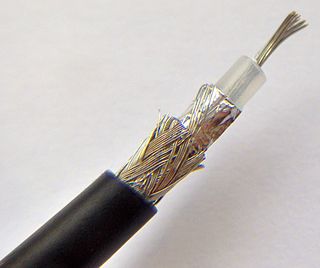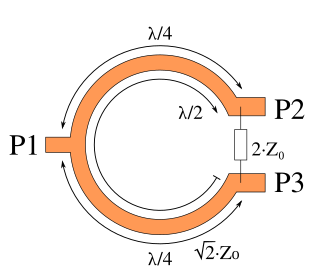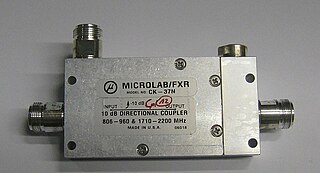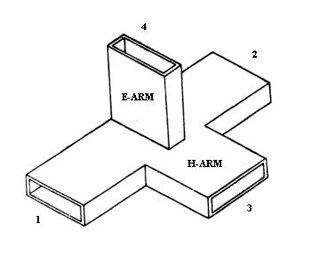
An amplifier, electronic amplifier or (informally) amp is an electronic device that can increase the power of a signal. It is a two-port electronic circuit that uses electric power from a power supply to increase the amplitude of a signal applied to its input terminals, producing a proportionally greater amplitude signal at its output. The amount of amplification provided by an amplifier is measured by its gain: the ratio of output voltage, current, or power to input. An amplifier is a circuit that has a power gain greater than one.

A circulator is a passive, non-reciprocal three- or four-port device that only allows a microwave or radio-frequency signal to exit through the port directly after the one it entered. Optical circulators have similar behavior. Ports are where an external waveguide or transmission line, such as a microstrip line or a coaxial cable, connects to the device. For a three-port circulator, a signal applied to port 1 only comes out of port 2; a signal applied to port 2 only comes out of port 3; a signal applied to port 3 only comes out of port 1, and so on. An ideal three-port circulator has the following scattering matrix:
In telecommunications and electrical engineering, electrical length refers to the length of an electrical conductor in terms of the phase shift introduced by transmission over that conductor at some frequency.

A hybrid coil is a transformer that has three windings, and which is designed to be configured as a circuit having four ports that are conjugate in pairs.
In radio engineering and telecommunications, standing wave ratio (SWR) is a measure of impedance matching of loads to the characteristic impedance of a transmission line or waveguide. Impedance mismatches result in standing waves along the transmission line, and SWR is defined as the ratio of the partial standing wave's amplitude at an antinode (maximum) to the amplitude at a node (minimum) along the line.

In electrical engineering, a transmission line is a specialized cable or other structure designed to conduct electromagnetic waves in a contained manner. The term applies when the conductors are long enough that the wave nature of the transmission must be taken into account. This applies especially to radio-frequency engineering because the short wavelengths mean that wave phenomena arise over very short distances. However, the theory of transmission lines was historically developed to explain phenomena on very long telegraph lines, especially submarine telegraph cables.

An antenna tuner is a device that is inserted between a radio transmitter and its antenna; when properly adjusted (tuned) it improves power transfer by matching the impedance of the radio to the impedance of the antenna, or the feedline which connects the antenna to the transmitter.
A Colpitts oscillator, invented in 1918 by American engineer Edwin H. Colpitts, is one of a number of designs for LC oscillators, electronic oscillators that use a combination of inductors (L) and capacitors (C) to produce an oscillation at a certain frequency. The distinguishing feature of the Colpitts oscillator is that the feedback for the active device is taken from a voltage divider made of two capacitors in series across the inductor.

In the field of microwave engineering and circuit design, the Wilkinson Power Divider is a specific class of power divider circuit that can achieve isolation between the output ports while maintaining a matched condition on all ports. The Wilkinson design can also be used as a power combiner because it is made up of passive components and hence reciprocal. First published by Ernest J. Wilkinson in 1960, this circuit finds wide use in radio frequency communication systems utilizing multiple channels since the high degree of isolation between the output ports prevents crosstalk between the individual channels.
Scattering parameters or S-parameters describe the electrical behavior of linear electrical networks when undergoing various steady state stimuli by electrical signals.

An attenuator is an electronic device that reduces the power of a signal without appreciably distorting its waveform.

Power dividers and directional couplers are passive devices used mostly in the field of radio technology. They couple a defined amount of the electromagnetic power in a transmission line to a port enabling the signal to be used in another circuit. An essential feature of directional couplers is that they only couple power flowing in one direction. Power entering the output port is coupled to the isolated port but not to the coupled port. A directional coupler designed to split power equally between two ports is called a hybrid coupler.
An all-pass filter is a signal processing filter that passes all frequencies equally in gain, but changes the phase relationship among various frequencies. Most types of filter reduce the amplitude of the signal applied to it for some values of frequency, whereas the all-pass filter allows all frequencies through without changes in level.
Admittance parameters or Y-parameters are properties used in many areas of electrical engineering, such as power, electronics, and telecommunications. These parameters are used to describe the electrical behavior of linear electrical networks. They are also used to describe the small-signal (linearized) response of non-linear networks. Y parameters are also known as short circuited admittance parameters. They are members of a family of similar parameters used in electronic engineering, other examples being: S-parameters, Z-parameters, H-parameters, T-parameters or ABCD-parameters.
Impedance parameters or Z-parameters are properties used in electrical engineering, electronic engineering, and communication systems engineering to describe the electrical behavior of linear electrical networks. They are also used to describe the small-signal (linearized) response of non-linear networks. They are members of a family of similar parameters used in electronic engineering, other examples being: S-parameters, Y-parameters, H-parameters, T-parameters or ABCD-parameters.

The Π pad is a specific type of attenuator circuit in electronics whereby the topology of the circuit is formed in the shape of the Greek capital letter pi (Π).

The bridged-T delay equaliser is an electrical all-pass filter circuit utilising bridged-T topology whose purpose is to insert an (ideally) constant delay at all frequencies in the signal path. It is a class of image filter.

A magic tee is a hybrid or 3 dB coupler used in microwave systems. It is an alternative to the rat-race coupler. In contrast to the rat-race, the three-dimensional structure of the magic tee makes it less readily constructed in planar technologies such as microstrip or stripline.

An isolator is a two-port device that transmits microwave or radio frequency power in one direction only. Due to internal behavior, the propagation in one direction is allowed while the other direction is blocked. The non-reciprocity observed in these devices usually comes from the interaction between the propagating wave and the material, which can be different with respect to the direction of propagation.

Distributed-element circuits are electrical circuits composed of lengths of transmission lines or other distributed components. These circuits perform the same functions as conventional circuits composed of passive components, such as capacitors, inductors, and transformers. They are used mostly at microwave frequencies, where conventional components are difficult to implement.
















